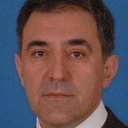[Anesthesiologic problems in patients with Launois-Bensaude-Madelung disease. Clinical case].
Atslēgvārdi
Abstrakts
Authors report a Launoise-Bensaude-Madelung disease case, in a 64 year old man, admitted to a Plastic Surgical Department for obesity, dysphonia, dysphagia, dyspnea. Early symptoms appeared 20 years before Hospital admission. Lipomatous tissue occupied nape, mandible, neck and shoulders. Surgical exeresis of lipomatous tissue under general anesthesia needed for the patient. Neck movements and mouth opening were short (Mallampati Score = 4); a neck computed tomography showed a tracheal compression and right displacement. Tracheal intubation was considered difficult or impossible. Nose-tracheal intubation was performed using a pediatric fiberoptic instrument as guide for a small gauge tracheal tube. Tracheal stenosis required many attempts for correct nose-tracheal intubation. Fiberoptic instrument as guide for tracheal tube can be useful for patients with Launoise-Bensaude-Madelung disease, when tracheal intubation is considered difficult or impossible. Knowledge of fiberoptic tracheal intubation techniques is mandatory for anesthesiologists, allowing tracheal intubation in patients with anatomical variations of mouth or upper respiratory airways.


